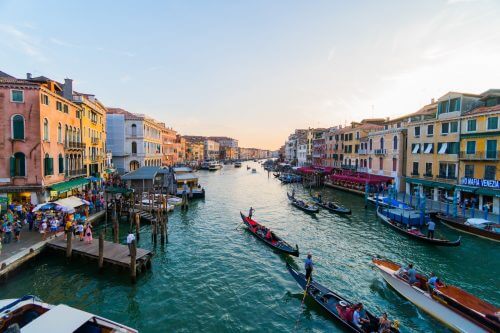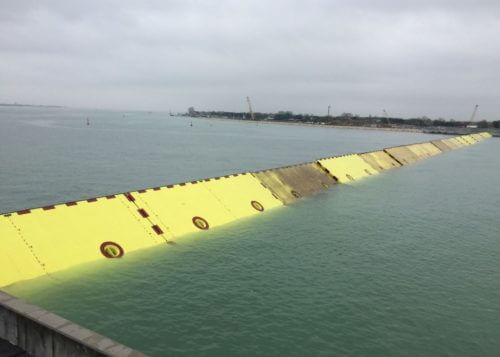Cities around the world are looking for solutions to deal with the expected sea level rise later in the century; Will a giant project built in Venice help to protect it from drowning or is it actually a multi-billion dollar pit?

By Maya Falah, Angle, Science and Environment News Agency
Sailing across the canal in a gondola at dusk, the beautiful streets and buildings of the old city pass you by. The smell of coffee in the air, gentle Italian music emanating from a nearby restaurant. Is there a more romantic place than Venice? Well, it's probably best to believe so - because we may soon have to replace the gondolas with submarines, and the espresso with a shot of salty sea water.
With the rise in sea level predicted for the rest of the century, Venice - which is uniquely built as a "floating city" on a lagoon of the Adriatic Sea and also suffers from a slow subsidence process of about 2 millimeters per year - may find itself increasingly flooded by rising waters. Sea level rise is not a distant apocalyptic prediction. Many studies from recent years show that this horror scenario is happening here and now and at a faster pace than we thought. If left unchecked, sea level rise could leave entire parts of the world as we know it today underwater. Current forecasts speak of A dramatic increase של between a meter number Meters At the level even before the end of the 21st century and it is possible that already towards 2050 we will see a significant rise in the sea level.
In addition, new studies claim that once the increase passes a certain height threshold, it will occur at once And not gradually and at a constant rate as was commonly thought. Such a development may leave us very little time to properly prepare for damages that may occur.
stop the sea
Various countries and cities around the world have begun to realize in recent years that this is indeed a serious threat that must be taken into account and that care and resources must be devoted to it. In various places they have already begun to plan and build engineering solutions aimed at stopping the sea. The most common solution is the construction of huge walls, which are usually made of massive concrete, called sea walls (Sea Walls), but the construction of this type of wall has a price, the disappearance of the sandy beach strip adjacent to it due to the return of the wave energy by the wall and the drifting of the sand. Even the US president, Donald Trump - who according to his statements (and tweets) does not really believe in climate change - have received recently Approval His request to build a protective wall in Ireland against the rising sea, this is to protect against flooding on a golf course he owns. Trump's first request A massive concrete sea wall over two kilometers long was to be built, with the main reason stated in the environmental affidavit accompanying the request being that "the existing frequency of flooding will continue and even worsen due to sea level rise in the coming years, and will pose a real and immediate risk to most of the front of the golf course and its properties." After this request was rejected, Trump was approved to build two breakwaters with a total length of nearly a kilometer, which will protect certain areas of the field that are under threat of flooding during strong storms.
With all due respect to the assets of the world's most powerful man, many other areas are under the ever-increasing maritime threat. It is understood that the meaning of sea level rise is not the same in different parts of the world: settlements that are built close to the coastline and on a relatively flat earth route are right on the danger line and are expected to suffer more than others. Venice is one of the places that will suffer from the rise in sea level at a relatively early stage, and even today it is sometimes subject to cases of flooding that hurt Difficult in the routine Life in her. Today this only occurs when there are unusual storms that cause high waves and particularly strong tides, but the expectation is that as sea levels rise, the city will find itself יותרAnd more under water.
Will Moses save Venice?
A study published last year predicts that if global warming (causing sea level rise) continues at the rate it is currently occurring, in about a hundred years Venice - along with five other areas located on the Italian Adriatic coast.
So what do you do in Venice to prepare for this trouble? The Venetians decided not to settle for a simple sea wall. In 2002, the construction of a huge, high-budget construction project was approved, which received the abbreviated name MOSES (a nod to the biblical Moses who managed to cross the sea in two), and which was designed to delimit the sea outside the lagoon and prevent it from flooding the city during storms and tidal currents. Similar to a sea wall, the project is indeed a massive engineering monster - but it is a much more sophisticated structure: MOSE is built of rows of huge gates located at three sensitive outlets of the lagoon, from which the sea flows in and congests the city's canals during storms. The goal is to close the gates and isolate the lagoon from the sea during strong storms that bring with them the danger of flooding. Unlike a sea wall that is permanently in place and creates a buffer between the settlement and the sea, this is an adjustable solution - that is, one that will cut off the city from the sea only when necessary, which should allow, for example, open shipping lanes, and also a more normal existence for the ecosystem in the area.

The gates are built so that normally they will be laid open on hinges connected to a permanent embankment at the bottom of the lagoon. When the forecast foretells of an approaching storm or the prospect of an abnormal tide, a stream of compressed air will empty the water holding the gates in place and allow them to turn on their axes, rise to the surface of the water and create a barrier that will stop the sea from flooding the lagoon and subsequently the city. During the storm, the gates will fill with water again and return to their original position near the bottom. This process will occur when the tide exceeds 110 centimeters, but according to MOSE's specifications, the gates are able to temporarily block even a tide that reaches a height of up to 3 meters.
Limited warranty protection
It may sound good, beautiful and very sophisticated on paper, but The project The grandiose Encountered through without-A little Difficulties, huge budget deviations and sharp criticisms. Today - almost 15 years since work began on it - it still has not started functioning. The company that manages it expects it to start operating in 2018, but so far there have been many delays in the planned schedule and a huge deviation from the budget: the project was estimated at 1.3 billion dollars during the planning stages, but the cost is currently close to 6 billion dollars, and the arm is still tilted. In addition to the pace and budget, the project was clouded by a major corruption scandal: in 2014, 35 politicians and businessmen associated with the projectwere arrested with accusations variance של corruption (like giving bribes and bribes in millions of dollars) - and finally Giorgio Orsoni, the mayor of Venice at the time, was removed from his position.
The problems do not end here: since it is an adjustable barrier and not a stable wall that is permanently in place, it is expected to require constant, complex and very expensive maintenance. The maintenance costs were estimated at the time of the planning and approval of the project at about 12 million dollars per year "only", but the project management currently estimates them at about 50 million dollars per year, and some also claim that the amount can even reach about 80 million - depending on the amount of flooding that affects the lagoon that year (Which, as mentioned, is expected to become an increasingly frequent matter according to the climatic forecasts).
But after all the delays, difficulties and slanders, will MOSE really succeed in doing the job, and prevent Venice from drowning under the sea level? The answer is probably "yes, but..." This is a promise with a limited guarantee, since the barrier is designed to deal mainly with temporary flooding cases, which result from strong storms - after which the fury will pass and the water will return to its original height. Sea level rise is expected to present him with a much more complicated challenge. While temporarily the gates can reach a height of about 3 meters above the current sea level - more than enough, according to most forecasts (although not all), to deal with a rise in the sea level at least in the coming decades - this protection is only possible in the situation where the gates are raised to their highest height. The problem is that they are not built to stay in this state permanently. According to the project's management, they believe that the barrier can handle a permanent rise in sea level of only up to about 60 centimeters - much lower than the temporary barrier. In addition to the fact that many of the currently accepted scenarios predict a much higher increase by the end of the century, according to the forecasts, climate change will also bring with it more and more cases of extreme storms - which are expected to greatly increase the frequency and intensity of flooding. Even in an optimistic scenario according to which the sophisticated barrier will be able to cope with these storms, this is expected to greatly increase the need for its ongoing maintenance - which, as mentioned, will incur a correspondingly high price.
The question then is, is the complexity of the project really justified? The forecasts for sea level rise and the frequency of flooding have indeed changed quite a bit in the 15 years that have passed since the project was launched, and it may have seemed justified to invest in the construction of an adjustable facility that would protect the city only when there was a real need for it; But today - a decade and a half and billions of dollars later - this investment and the thinking that led to it looks more and more ridiculous, especially considering that the facility has not even started operating yet. Today - whether we accept the more or less severe scenarios - there is no longer any doubt thatPreparation to the ascent של penny the sea She Necessary, and one can only congratulate countries that are willing to invest large sums in this thinking of the enormous damages that such preparation will prevent in the future; But if you're already investing in trying to stop the sea - it's important to do it wisely, and not throw huge sums into the water that will drown along with our cities.
See more on the subject on the science website:
